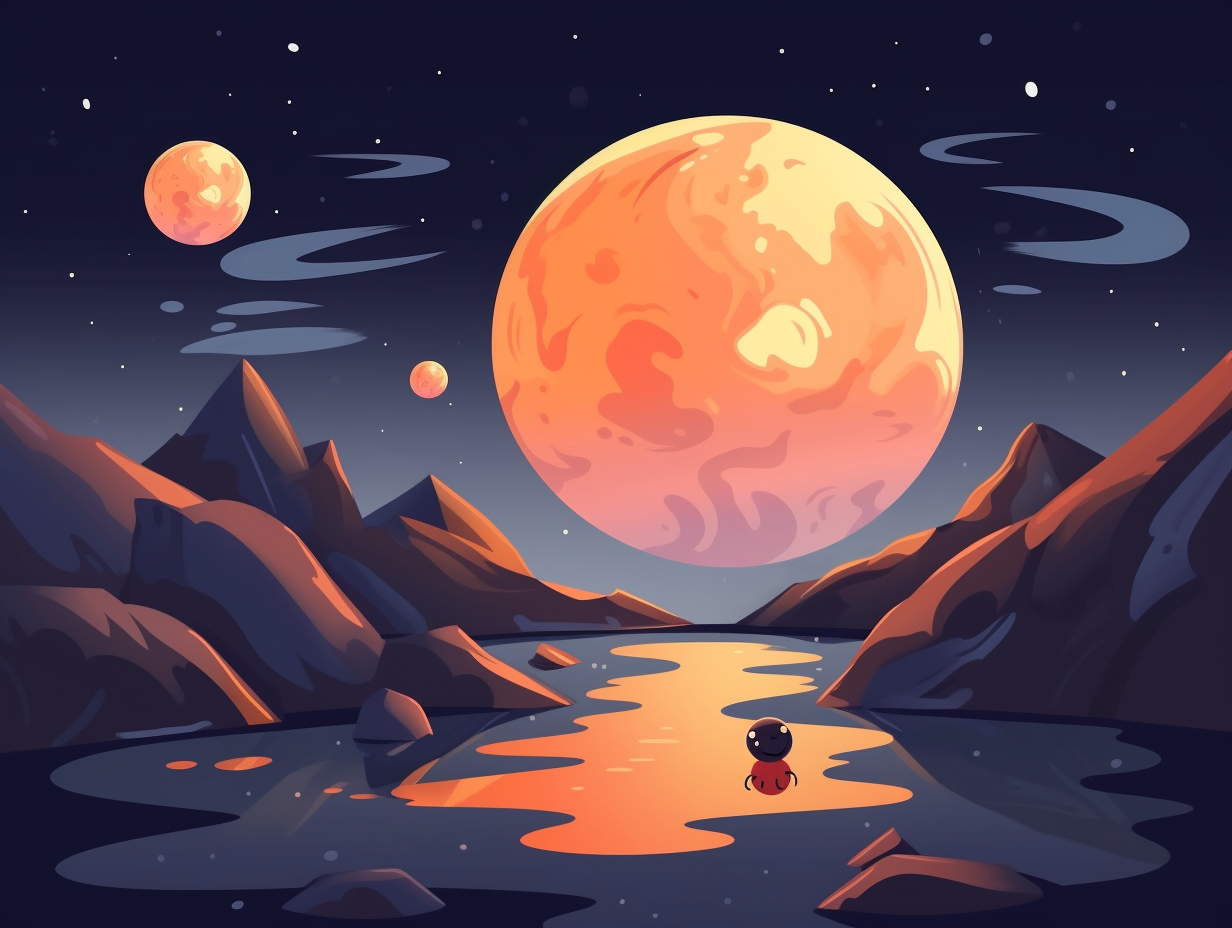Discover the Wonders of Space: Top 27 Fun and Fascinating Facts About Mercury!

1. A Long Day at Mercury's Office
Talk about a long day at the office: A day on Mercury lasts a jaw-dropping 176 Earth days, so you'd have plenty of time to catch up on your solar crossword puzzles while waiting for the Sun to rise, set, and rise again to the same spot in the sky.
Source => universetoday.com
2. Mercury's Gym Membership and Core Muscles
Who needs gym memberships when you're Mercury, am I right? This tiny galactic flexer isn't just all muscle, but also more massive and compact than its size suggests: With a density of 5.427 g/cm3, Mercury boasts the highest density of any planet in the Solar System and a 42% iron-rich core that keeps scientists swooning over its structure and composition.
Source => universetoday.com

Did you know that a day on Venus is longer than a year? Its stormy atmosphere slows down its rotation, making it the ultimate slowpoke in the solar system! Discover more fascinating facts about Venus!
=> Fun Facts about Venus
3. Mercury's Extreme Mood Swings
If Mercury had a Tinder profile, it would say "Looking for someone who can handle extreme mood swings!": This tiny celestial speedster experiences the wildest temperature fluctuations in the solar system, with scorching daytime highs of 800°F (427°C) and frosty nighttime lows of -290°F (-180°C), even though it's not the hottest planet out there.
Source => space.com
4. Hot Planet, Cold Poles
Who needs a freezer when you're on the hottest planet in the solar system? Mercury gives a new meaning to chilling on ice: Despite its sweltering surface temperatures, Mercury surprises us by harboring pockets of water ice hiding in craters and shadowy terrain near its north pole, making it an unexpectedly frosty destination in our celestial neighborhood.
Source => space.com

5. Mercury's Frosty Shindig
Hold on to your ice skates, folks – Mercury's throwing a frosty little shindig in the depths of its shadowy poles: Permanently tucked away from sunlight, at least 20 inches (50 cm) of water ice accumulated on Mercury's poles, totaling between 100 billion to a trillion tons, as discovered by NASA's Messenger spacecraft after 1 1/2 years of orbiting the innermost planet and passing three stringent tests for its existence.
Source => skyandtelescope.org
6. Mercury's Skipped Leg Day
If Mercury were a gym junkie, it would definitely be guilty of skipping leg day in favor of working on its core: The smallest planet in our solar system boasts an iron core that is more than half its diameter, larger than initially believed, due to the sun's magnetism attracting iron grains during the formation of the solar system. Furthermore, the dense core is also a result of Mercury hoarding the largest amount of iron filings compared to its fellow rocky planets.
Source => dailymail.co.uk
7. Mercury's Indecisive Orbit
Mercury's like that indecisive aunt who comes too close for comfort at family gatherings and then drifts off awkwardly: Its highly elliptical orbit takes it as close as 29 million miles and as far as 43 million miles from the sun, making it the proud owner of the most eccentric orbit in the solar system.
Source => space.com
8. Mercury's College All-Nighter
If Mercury were a college student, it would be guilty of extreme all-nighters and marathon study sessions: A day on the planet lasts a whopping two Earth years, while its year is a mere 88 Earth days long, making its solar day last 176 Earth days. Talk about putting the "mercurial" in "scheduling"!
Source => universetoday.com
9. The Celestial Boomerang Effect
Ever felt like you were going two steps forward and one step back? Mercury's got you beat: at certain points on its surface, the Sun appears to rise, start setting, then change its mind and rise again before truly setting – all in the same Mercurian day! This celestial boomerang effect happens four Earth days before and after Mercury's closest distance to the Sun and is due to its elliptical orbit and peculiar angular speeds. From specific spots on its equator, the Sun even passes overhead three times in alternate Mercurian years, making these locations the hottest hotspots on the entire planet.
Source => space.stackexchange.com

10. Sunbathing and Lunar Weight Loss
Feeling a little hot under the collar? Don't sweat it, you're just on Mercury: With a surface temperature reaching a sweltering 800 degrees Fahrenheit during the day, this solar system speedster zips around the sun in just 88 Earth days, making it our sun's nearest planetary neighbor. Don't worry about packing on the pounds for this trip, though – Mercury's surface gravity is only 38% of Earth's, so you'll weigh a whole lot less during your interplanetary vacay.
Source => coolcosmos.ipac.caltech.edu
11. Mercury's Cosmic Cocktail Atmosphere
In a galaxy not so far away, the little planet Mercury was caught by onlookers whipped cream-handed, chugging up a wild cosmic cocktail of elements: Mercury's puny exosphere, although thinner than an introverted flat-earther's social circle, has a vibrant mix of sodium, magnesium, calcium, hydrogen, helium, potassium, and just a dash of oxygen to keep the space connoisseurs guessing.
Source => space.com
12. Mercury's Past and Future Rings
Mercury, the mischievous rascal of the solar system, might be jealous of its bling-studded neighbors flaunting their fabulous icy rings: but there's a possibility that the little planet had rings in the past, and maybe even again in the future - provided it finds a way to overcome its fascination with the fiery Sun and manages without a moon buddy to play the gravitational game.
Source => universetoday.com
13. Master Chef Mercury
Mercury, the solar system's master chef, is taking temperatures to the extreme: From a scorching 800 degrees Fahrenheit (425 degrees Celsius) on its sunny side to a chilling -290 degrees Fahrenheit (-180 degrees Celsius) on its night-time face, this little planet truly knows how to keep things interesting!
Source => space.com
14. Scorching Days, Freezing Nights
If Mercury had its own tourism slogan, it might just be: "Come for the steamy-hot sunbathing, stay for the icy-cold nights!" But really: Mercury's surface temperature fluctuates drastically from a scorching 801°F during the day to a bitter -279°F at night, making it a not-so-ideal vacation spot for human habitation.
Source => coolcosmos.ipac.caltech.edu

15. Deep Sea's High Mercury Levels
Feeling a bit "loony" over the marvels of the deep sea? Surprise, surprise! Those mysterious trenches are accumulating more than just National Geographic specials and old episodes of "The Abyss": Mercury levels found in these previously unmeasured trenches reach alarmingly high concentrations, up to 56 times greater than prior estimates, rivaling some of the most contaminated waters on Earth despite the absence of known nearby sources – a startling fact reminding us that the Minamata Convention's global efforts to reduce environmental mercury are no laughing matter.
Source => arstechnica.com
16. Mysterious Ghost Tail
Ever heard of the planet with the good-humored ghost tail? That's right, Mercury is the silent comedian of our Solar System: This jovial planet's thin atmosphere creates a 2-million-kilometer long tail made of atoms like sodium and calcium, with most neutral atoms escaping its gravity while some fancy particles decide to fall back onto Mercury's surface for a quick encore.
Source => space.com
17. House of Gravitons and Magnetic Wand
Mercury, known for taking the "size doesn't matter" mantra to heart and cranking up the "it's what's inside that counts" vibe: This tiny planetary powerhouse has a magnetic field that's only about 1% as strong as Earth's, with its magnetic poles rocking a bit off-kilter from its geographic poles, all thanks to its spicy, liquid outer core party.
Source => windows2universe.org
18. Cliff-Hanging Lava Surfing
If Mercury were a party guest, it'd be the mysterious one with unique tattoos and a penchant for lava surfing: The surface of this fascinating planet is home to smooth plains, steep cliffs, and one-of-a-kind landforms, including the lava-flooded Caloris Basin, the "wheel and spoke" pattern of the Rembrandt Basin, as well as lobate scarps, ridges and troughs shaped by various geological forces.
Source => airandspace.si.edu
19. Wizard School for Magnetic Fields
If Mercury were a wizard, it would belong to the House of Gravitons with a weak magnetic wand: In reality, it has a magnetic field that’s way weaker than Earth’s, but the discovery of small magnetic patches on the planet suggests that this tiny celestial body might’ve once wielded a much stronger field, possibly during its mischievous, youthful days.
Source => en.wikipedia.org
20. Mercury's Walk of Fame
Step aside, Hollywood Walk of Fame: Mercury's got its own interstellar academy, littered with craters named after celebrated artists, writers, and composers! Seriously though: Out of Mercury's 414 named craters, they're designated after such creative luminaries, adhering to the International Astronomical Union's naming conventions, with craters larger than 250 km being classified as "basins."
Source => en.wikipedia.org
21. Ice Cream in the Desert
If Mercury were an ice cream, it would be a desert scorcher by day and a popsicle paradise by night: With scorching daytime temperatures reaching up to 427°C (800°F) thanks to its close relationship with the Sun, this seemingly ludicrous planet manages to boast chilly poles hosting reservoirs of water ice as well, shielding ice mass weighing about 0.025–0.25% of the Antarctic ice sheet from the Sun's direct rays.
Source => en.wikipedia.org
22. Celestial Whiplash
Hold onto your hats, because Mercury's mood swings might give you a case of celestial whiplash: This tiny planet's temperature plummets from scorching highs of 800 degrees Fahrenheit during the day to freezing lows of -290 degrees Fahrenheit at night, making it the solar system's most extreme thermostat!
Source => wondriumdaily.com
23. Intergalactic Mountaineering
Move over, Mount Everest! The Caloris Montes will have you laughing all the way to the moon and back with their out-of-this-world origin story: These lunar mountains, with a modest height of 3 km, were born from the epic Caloris impact that resulted in one of the largest craters in the solar system, stretching 1,550 km in diameter - a testament to the cosmic power of making a lasting impression.
Source => en.wikipedia.org
24. Usain Bolt of Planets
If Mercury were an overachiever in a cosmic footrace, they'd be the Usain Bolt of planets – racing around the sun, all while living life in slow motion: Mercury takes only 88 Earth days to orbit the sun, but one day on Mercury lasts a whopping 176 Earth days due to its leisurely rotation.
Source => britannica.com
25. Magnetic Field Confusion
Why did Mercury's magnetic field cross the road? To confuse scientists on the other side! This planetary punchline has experts in stitches: Mercury boasts an unusually imbalanced magnetic field, with its northern hemisphere being three times stronger than the southern, likely due to its iron core solidifying uniquely at its outer boundary instead of the inner, as revealed by NASA's MESSENGER mission and a model co-authored by Professor Christopher Russell from the University of California.
Source => space.com
26. Mercury's Slow Dance
In a cosmic game of "Simon Says," Mercury just can't seem to keep up with its neighbors when it comes to subtle dance moves: due to the warping of spacetime caused by massive celestial bodies like the sun and planets, as predicted by Einstein's theory of general relativity, Mercury's orbit experiences a slight mismatch between predictions and observations, an effect so minute it took scientists years to discover.
Source => sciencenews.org
27. Mercury's Oven Temperature Swings
Mercury: the celestial chef that can't make up its mind on oven temperatures! From frozen TV dinners to a scorching deep-fried turkey, this little planet offers the ultimate cookery conundrum: a surface temperature swing between -290 to 800°F, making it the globetrotter of planetary extremities and a true challenge for aspiring space colonizers.
Source => thebahamasweekly.com
Related Fun Facts




















